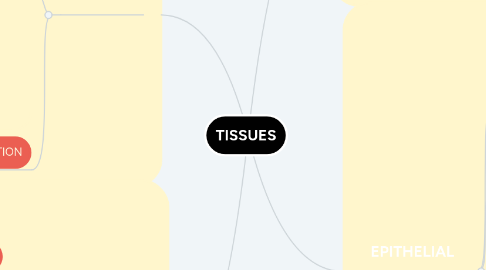
1. MUSCLE
1.1. TYPES
1.1.1. Skeletal
1.1.1.1. voluntary movements
1.1.1.2. skin and bones
1.1.1.3. elongated cells
1.1.2. Cardiac
1.1.2.1. propels blood into the circulation
1.1.2.2. walls of the heart
1.1.2.3. short branched cells
1.1.3. Smooth
1.1.3.1. propels substances along internal passageways
1.1.3.2. walls of hollow organs
1.1.3.2.1. digestive tract
1.1.3.2.2. bladder
1.1.3.2.3. arteries
1.1.3.3. spindle-shape cells
1.2. GENERAL FUNCTION
1.2.1. MOVEMENT
2. CONNECTIVE
2.1. GENERAL FUNCTIONS
2.1.1. BINDING OF DIFFERENT BODY STRUCTURE
2.1.2. TRANSPORT OF MATERIALS
2.1.3. IMMUNITY
2.1.4. SUPPORT
2.1.5. PROTECTION
2.2. CHARACTERISTICS
2.2.1. widely spread
2.2.2. filled with exracellular matrix
2.2.2.1. consists of ground substance and fibers
2.2.3. highly vascular
2.3. TYPES
2.3.1. Loose Connective Tissue
2.3.2. Dense Connective Tissue
2.3.2.1. Ligament
2.3.2.2. Tendon
2.3.3. Bone Connective Tissue
3. NERVOUS
3.1. GENERAL FUNCTIONS
3.1.1. control the body
3.1.2. coordinate with body parts
3.2. CATEGORIES
3.2.1. neurons
3.2.2. neuroglia
3.3. STRUCTURES
3.3.1. Dendrites
3.3.1.1. rootlike extensions
3.3.1.2. receive the stimuli/nerve impulses
3.3.2. Cell body
3.3.2.1. location of nucleus
3.3.3. Axon
4. EPITHELIAL
4.1. GENERAL FUNCTIONS
4.1.1. PROTECTION
4.1.2. ABSORPTION
4.1.3. SECRETION
4.1.4. EXCRETION
4.2. CHARACTERISTICS
4.2.1. apical and basal
4.2.2. avascular
4.2.3. highly mitotic
4.2.4. neural connections
4.3. CLASSIFICATIONS
4.3.1. SHAPES
4.3.1.1. Squamous
4.3.1.1.1. flattened cells
4.3.1.2. Cuboidal
4.3.1.2.1. cube-like cells
4.3.1.3. Columnar
4.3.1.3.1. column0like cells
4.3.2. ARRANGEMENT
4.3.2.1. Simple
4.3.2.1.1. one cell layer
4.3.2.2. Stratified
4.3.2.2.1. several layers of cells
4.3.2.3. Pseudostratified
4.3.2.3.1. single layer
4.3.2.4. Transitional
4.3.2.4.1. stretch and return
4.3.3. FUNCTIONS
4.3.3.1. Mucuous membrane
4.3.3.2. Glandular Epithelium
4.3.3.3. Endothelium
4.3.3.4. Mesothelium

